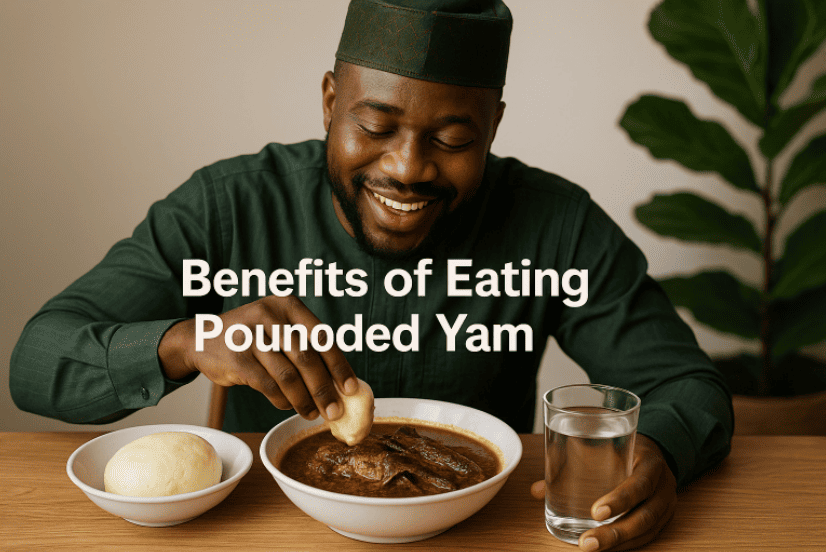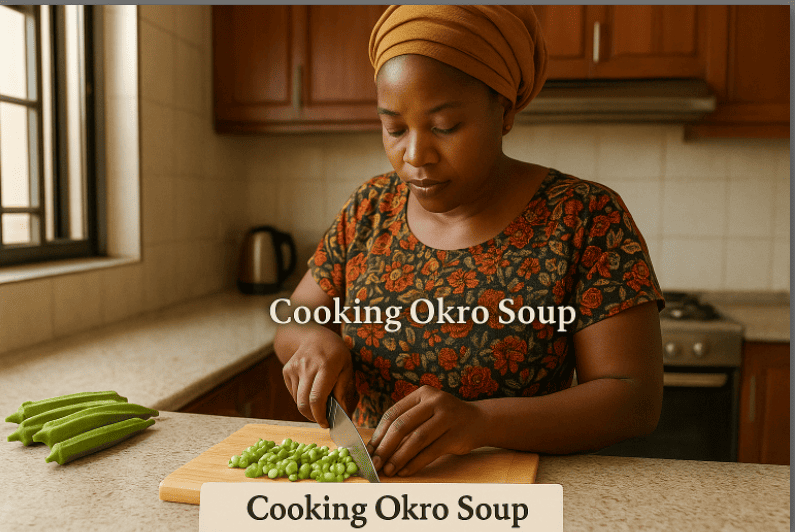Just imagine that it is Sunday afternoon in a typical Nigerian home. The aroma of egusi soup fills the air, children are setting the table, and in the kitchen, someone is pounding yam with that rhythmic “kpom-kpom-kpom” that echoes like a local drum of joy. If you didn’t grow up hearing that sound, did you even have a real village experience? In case you are lost, I am talking about pounded yam.
Pounded yam is more than just food. It’s emotion. It’s tradition. It’s the way our mothers showed love, and the star of many owambe buffets. Whether you’re Team Fufu or Team Semo, there’s something about pounded yam that speaks to the soul—especially when it’s paired with thick draw soup or pepper-rich egusi. But beyond the delicious taste and cultural memories, pounded yam is also loaded with health benefits you might not know.
In this post, we’ll break down the top 14 health benefits of eating pounded yam. By the end, you’ll appreciate this cherished Nigerian swallow even more—and maybe even feel like making a fresh batch.
It will interest you to discover why Nigerian chicken and chips remain a favorite street and restaurant delight. From crispy fried chicken to golden chips, learn its origin, unique taste, health insights, and why Nigerians love this classic combo.
Understanding Pounded Yam and its Origin
Pounded yam traces its origin to West Africa, with Nigeria as its proud custodian. The African yam (Dioscorea rotundata) has been cultivated in this region for thousands of years, long before rice and spaghetti found their way into our kitchens. Early Nigerians discovered that while yam was delicious when boiled or roasted, pounding it in a mortar with a pestle transformed it into something smoother, stretchier, and far more satisfying.
This pounding tradition wasn’t just about food — it was about innovation, creating a meal that could perfectly carry soups like egusi, ogbono, or bitterleaf without crumbling apart. Over time, what started as a practical cooking method grew into a cultural delicacy.
Cultural Significance
In Nigeria, pounded yam is not just food — it’s an experience. It represents warmth, love, and togetherness. That’s why you’ll often find it steaming hot at weddings, naming ceremonies, Christmas, New Year, and big family gatherings. Offering someone pounded yam is like saying, “You are special to us.” In fact, in some homes, visitors are rated by the meal they are served — and if you’re offered pounded yam, know you’ve been given first-class treatment.
Common Among Many Nigerian Ethnic Groups:
Pounded yam is not just food — it’s culture on a plate. From weddings to festivals, it’s a meal loved across Nigerian ethnic groups, symbolizing hospitality, pride, and family tradition:
• Among the Yoruba: Known as iyan, pounded yam is seen as a prestigious meal. In traditional Yoruba homes, serving a guest pounded yam with efo riro or egusi soup is the height of honor. Weddings, naming ceremonies, and festive seasons are incomplete without it.
• Among the Igbo: Pounded yam is a loyal partner to soups like ofe nsala (white soup) and ofe onugbu (bitterleaf soup). For the Igbo, pounded yam is not everyday food — it is special, reserved for Sundays, Christmas, or when visitors of high esteem arrive.
• Among the Edo and Delta peoples: Pounded yam often takes center stage during rituals, festivals, and royal gatherings. It represents wealth, family, and tradition.
Best Way To Eat Pounded Yam
There’s a special ritual to eating pounded yam. You pinch off a piece with your fingers, roll it smoothly, dip it into a rich soup like ogbono, afang, egusi, or nsala, and then let it slide down. No chewing needed — just swallow and smile. For many Nigerians, the taste of pounded yam mixed with hot, spicy soup is comfort food at its finest. It’s the kind of meal that makes you loosen your belt and say, “life is good.”
Why People Love It
So why does pounded yam stand out among all the “swallows” like eba, semo, or fufu? It’s simple: the smooth texture, unique taste, and satisfying feel. It fills the stomach, calms hunger, and gives that “complete meal” satisfaction. Unlike some other swallows that may feel heavy or sticky, pounded yam has that perfect balance — soft, stretchy, yet firm enough to hold the soup. No wonder many Nigerians boldly call it “the king of swallows.”
In short, pounded yam in Nigeria is more than food — it’s pride, it’s family, it’s tradition, and it’s a symbol of celebration.
Best Types of Yam Suitable for Pounded Yam
Not every yam is pounded yam material. If you’ve ever tried pounding the wrong yam, you already know the heartbreak — watery texture, sticky lumps, or pounded yam that feels more like chewing gum than soft swallow. The truth is, not all yams are created equal when it comes to pounding. The type of yam you choose can make or break your meal.
Here are the best types of yam that give you that smooth, stretchy, and heavenly pounded yam Nigerians love:
1. White Yam (Dioscorea rotundata) – The King of Pounded Yam
This is the most popular yam for pounding in Nigeria. White yam is starchy, fluffy, and pound-friendly. When cooked, it stays firm and smooth, making it easy to pound into that stretchy, lump-free swallow.
Best enjoyed with: Egusi, Ogbono, or Vegetable soup.
2. Water Yam (Dioscorea alata) – Not the First Choice
Water yam is softer and more watery than white yam. On its own, it doesn’t make the best pounded yam because it tends to be sticky and less stretchy. However, in some Nigerian homes, people mix a little water yam with white yam to give extra softness.
Best enjoyed with: Ogbono soup if you like a smoother, lighter swallow.
3. Yellow Yam – The Flavorful Option
Yellow yam is slightly less starchy than white yam and has a distinct flavor. It can be pounded, though the texture may not be as stretchy as white yam. Many people love it for its rich taste and color, which gives a unique twist to pounded yam.
Best enjoyed with: Palm oil-based soups like Ofe Akwu or Nsala.
4. New Yam (Freshly Harvested White Yam) – Soft but Tricky
When yam is newly harvested (around August–October in Nigeria), it is softer and contains more water. Pounding it may give a slightly sticky texture. Some people still love the freshness, while others prefer waiting until the yam is a bit older and firmer.
Best enjoyed with: Light soup or okro soup when you want that soft, melt-in-mouth swallow.
5. Yam Flour (Elubo / Instant Pounded Yam Flour) – The Shortcut
Technically not fresh yam, but many Nigerians use it for convenience. Brands like Poundo Yam flour are made from dried yam flour that mimics real pounded yam. While it saves time, most true yam lovers agree nothing beats pounding fresh white yam by hand.
Best enjoyed with: Any soup, especially when time or energy is limited.
If you want the classic, authentic pounded yam experience, White Yam (Dioscorea rotundata) is the best choice. Yellow yam can be used for variety, and yam flour is a practical alternative, but nothing beats the real deal — fresh white yam, pounded hot, and served steaming with rich Nigerian soup.
Health Benefits of Eating Pounded Yam
Now that we have explored what pounded yam is and its cultural roots, let’s dive into 14 powerful health benefits that make this beloved Nigerian dish more than just a satisfying meal:
1. Excellent Source of Natural Energy
Ever wondered why you could survive from morning till night after eating pounded yam? That’s because yam is a complex carbohydrate that digests slowly, releasing energy bit by bit — unlike sugary foods that give quick spikes and sudden crashes.
• Keeps you fuller for longer
• Ideal for students, workers, and anyone needing sustained strength
• Great pre- or post-workout meal
• Provides steady stamina without mid-day tiredness
In fact, back in the day, farmers would pound yam early in the morning before heading to the farm. That heavy meal underpinned their strength, keeping them going till evening under the scorching sun. Even today, many Nigerians testify that after eating pounded yam with egusi or vegetable soup, they can skip lunch without feeling weak. It’s a true “power food” that fuels both body and mind.
2. Promotes Healthy Digestion
Nobody likes that heavy, uncomfortable feeling after a meal. Thanks to its high fiber content, pounded yam supports digestion and helps prevent constipation. When paired with soups loaded with vegetables like ugu, ogbono, okra, or bitterleaf, it does more than fill your stomach — it gives your gut a gentle cleanse.
• Supports bowel regularity
• Reduces bloating and stomach discomfort
• Encourages the growth of good gut bacteria
• Helps the body absorb nutrients better
Instead of gulping down soda after eating, which can slow digestion and cause bloating, try warm water with a squeeze of lemon. It not only boosts digestion but also leaves you feeling light and refreshed. Back in the village days, elders often washed down yam meals with palm wine or plain water — simple habits that kept their digestion strong and natural.
3. Supports Weight Management
Now, let’s address the elephant in the room: can you eat pounded yam and still manage your weight? Absolutely — it all comes down to portion size and smart preparation. Because yam digests slowly, it helps curb cravings and keeps you full longer, making it a great choice when eaten right.
• Eat smaller, controlled portions
• Pair with lean proteins like fish, chicken, or goat meat
• Use less oil when preparing your soup
• Choose freshly pounded yam over processed flour for better nutrition
In fact, many nutritionists recommend eating pounded yam earlier in the day with light vegetable soup if you’re watching your weight. That way, you enjoy the satisfaction without loading calories too close to bedtime.
4. Strengthens the Immune System
Pounded yam rarely comes alone — it’s almost always paired with nutrient-packed soups. Palm oil is rich in vitamin A, vegetables bring vitamin C, while fish, goat meat, and stock fish supply zinc and iron. Together, this combination turns your meal into a powerful immunity booster.
• Boosts natural defense against diseases
• Helps fight common infections
• Supports faster wound healing
• Keeps the body resilient in harsh weather
That’s why a hot plate of pounded yam with vegetable soup during the rainy season is practically homegrown medicine. Our parents may not have called it “immune support,” but they knew it kept cough, catarrh, and malaria at bay.
5. Supports Women’s Health and Pregnancy
Pounded yam is more than comfort food for women — it’s a source of vital nutrients. Yams are naturally rich in folate and iron, which are crucial for pregnant and nursing mothers. Folate supports healthy fetal development, while iron prevents anemia and boosts energy levels.
• Aids proper fetal growth and brain development
• Prevents anemia and boosts blood health
• Provides strength for nursing mothers
• Supports reproductive wellness
Old wives’ tales say yam enhances fertility — and while the science is mixed, the nutrients are undeniably real. Many women testify to feeling stronger when pounded yam is included in their diet. Just remember: go light on the pepper if you’re breastfeeding, to keep both mother and baby comfortable.
6. Good for Skin and Anti-Aging
Believe it or not, pounded yam can actually contribute to glowing, youthful skin. Yams contain vitamin C and antioxidants that fight free radicals, promote collagen production, and slow down signs of aging.
• Rich in vitamin C and antioxidants
• Promotes collagen for firm, elastic skin
• Reduces wrinkles and early aging signs
• Helps skin heal and stay radiant
When paired with soups made from fresh vegetables like ugu, waterleaf, or scent leaf, you’re not just eating a meal — you’re giving yourself a natural beauty treatment from the inside out. Back in the day, elders used to say, “Beauty begins from the pot,” and pounded yam with vegetable soup proves that true.
7. A Feel-Good Comfort Food
Mental health is health too, and food plays a big role in it. There’s something deeply comforting about pounded yam and soup on a bad day — it feels like a hug from the inside.
• Reduces stress and calms the body
• Brings nostalgic joy and memories of home
• Encourages bonding during shared meals
• Boosts mood with steady energy release
Think about it: after a long, rainy day or a stressful Lagos commute, a steaming plate of pounded yam and egusi can melt away half your worries. It’s not just food — it is therapy, tradition, and togetherness all rolled into one.
8. Good for the Heart
Your heart works 24/7, so it needs proper care. Pounded yam contains potassium, a mineral that helps balance blood pressure and reduces strain on the heart. Combined with soups rich in leafy greens, it becomes a heart-friendly powerhouse.
• Helps regulate blood pressure
• Reduces risk of hypertension and stroke
• Supports long-term cardiovascular health
• Enhances circulation and stamina
No wonder our grandparents who regularly ate yam with vegetable soup often lived strong and active lives even into old age. Their meals weren’t just filling — they were naturally protecting their hearts with every bite.
9. Boosts Brain Function
Your brain is your body’s control center, and it needs the right fuel to stay sharp. Pounded yam delivers because yams are rich in vitamin B6, which supports brain development, improves memory, and balances mood.
• Enhances focus and concentration
• Supports nervous system function
• Reduces risk of stress-related fatigue
• Improves overall mental clarity
No wonder students preparing for WAEC or university exams often find comfort in a steaming plate of pounded yam and egusi. It doesn’t just fill the stomach — it sharpens the mind and calms the nerves, making it the ultimate “exam food” for many households.
10. Supports Bone and Teeth Health
Strong bones and teeth aren’t built in a day — they need a steady supply of minerals. Pounded yam provides magnesium and calcium, two nutrients that work hand-in-hand to strengthen bones, maintain healthy teeth, and keep joints flexible.
• Reduces the risk of osteoporosis in later life
• Keeps teeth strong and cavity-resistant
• Supports proper bone growth in children
• Promotes joint strength and flexibility
Back in the day, children who ate yam regularly were said to grow with “hard bones.” Today, science confirms that yam plays a vital role in bone health. Pairing it with soups rich in green vegetables like ugu or waterleaf boosts the calcium and iron even further.
11. Balances Hormones
Pounded yam doesn’t just satisfy hunger — it also plays a quiet role in hormone regulation. Yams contain natural plant compounds like diosgenin, which are believed to support hormonal balance, especially in women.
• Supports reproductive health
• Helps ease mood swings and hot flashes
• Encourages overall hormonal stability
• May improve menstrual cycle regularity
It’s no surprise that yam festivals in some Nigerian communities were tied to fertility and abundance. The food wasn’t only cultural; it symbolized vitality and life itself. Even today, many women find comfort in yam-based meals during delicate stages like pregnancy or menopause.
12. Helps Control Blood Sugar
One of yam’s best-kept secrets is its low glycemic index. Unlike sugary snacks or processed carbs that spike your blood sugar, yam releases energy slowly, keeping your sugar levels stable. This makes pounded yam a smarter choice for anyone watching their health.
• Helps regulate blood sugar naturally
• Reduces the risk of type 2 diabetes
• Provides steady energy without sudden crashes
• Supports long-term metabolic health
That’s why in many Nigerian homes, elders living with diabetes are encouraged to eat small, controlled portions of yam with vegetable-rich soups like ugu or bitterleaf. It’s a simple swap that keeps them enjoying their favorite meal while supporting a healthier lifestyle.
13. Supports Healthy Circulation
Good blood flow is life itself, and yam helps keep it strong. The iron in yam supports the production of healthy red blood cells, ensuring that oxygen circulates well in the body and fatigue stays far away.
• Reduces risk of anemia
• Boosts daily energy and vitality
• Enhances oxygen delivery to muscles and organs
• Supports overall stamina and growth
No wonder children in the village who ate yam regularly seemed to grow up strong and tireless — running, climbing trees, and playing football barefoot till dusk. Their bodies were fueled with iron and energy for healthy growth and endless stamina.
14. Reduces Inflammation
Inflammation is one of the silent enemies of good health, showing up as swollen joints, body pains, or slow healing. Yam contains natural antioxidants and anti-inflammatory compounds that help calm the body and speed up recovery.
• Eases arthritis and joint pain
• Supports faster healing after physical stress
• Promotes overall wellness and longevity
• Keeps hidden inflammation under control
Some elders even swore by yam with bitterleaf or uziza soup, saying it “washed the body.” Today, science confirms that wisdom: those soups, paired with yam, fight inflammation and help the body stay balanced and strong.
In Conclusion: From energy and digestion to glowing skin and a strong immune system, pounded yam does more than fill your stomach. It connects generations, feeds the soul, and nourishes the body. Next time you’re thinking of what to eat, remember: pounded yam isn’t just the best swallow in Nigeria, it’s a whole vibe – delicious, healthy, and proudly Nigerian.
So go ahead, serve it with your favorite soup and enjoy every bite – your body (and your spirit) will thank you.
FAQs About Pounded Yam
1. Is pounded yam healthy?
Yes, especially when eaten in moderation with healthy soups. It provides energy, fiber, and essential nutrients.
2. What is pounded yam made from?
It’s made from boiled yam that is pounded until smooth and stretchy. Traditional method uses a mortar and pestle.
3. Can I lose weight while eating pounded yam?
Yes – control your portion size and pair it with light, oil-free soups.
4. What’s the best soup for pounded yam?
Egusi, ogbono, oha, vegetable, and white soup are all classic pairings.
5. Is yam flour the same as pounded yam?
Not exactly. Yam flour (like poundo yam) is instant and processed. Pounded yam is freshly made from real yam tubers.
6. Is pounded yam better than semo or amala?
That depends on your preference and health goals. Each has its own benefits.
7. Can diabetics eat pounded yam?
Moderately. Yam has a medium glycemic index, so smaller portions and vegetable-based soups are best.
8. Can I make pounded yam without a mortar?
Yes! You can use a yam pounder or a strong blender or food processor.
9. Is pounded yam good for children?
Absolutely! It gives them energy and helps with growth when combined with nutrient-rich soups.
10. How do I store leftover pounded yam?
Wrap in cling film or put in a container. Refrigerate and reheat with a bit of water.
11. Can I freeze pounded yam?
Yes, but the texture may change slightly. Fresh is always best.
12. Is there a difference between white yam and yellow yam for pounding?
White yam is preferred for pounding because of its texture. Yellow yam tends to be harder and less stretchy.
13. Why is pounded yam considered the best swallow in Nigeria?
It’s smooth, stretchy, filling, and pairs well with almost every Nigerian soup. Plus, it’s got deep cultural roots.
I am very certain you enjoyed reading these 14 Health Benefits of Eating Yam that was Pounded; I will be very glad to have you also explore 10 powerful health benefits of scent leaf every Nigerian should know, from boosting immunity and improving digestion to fighting infections and supporting overall wellness.





